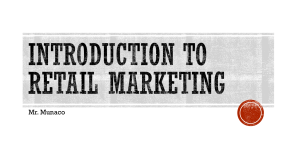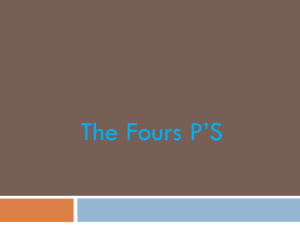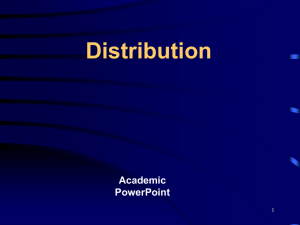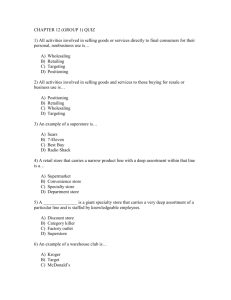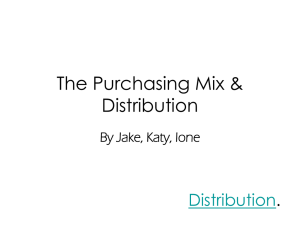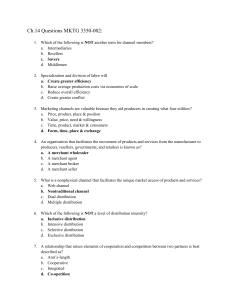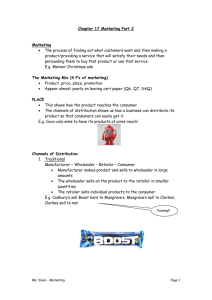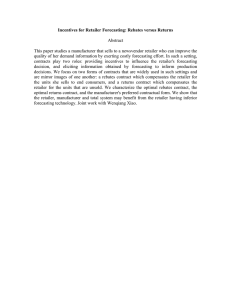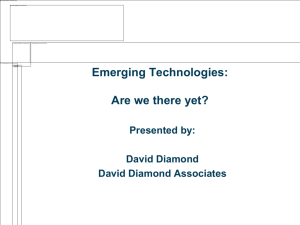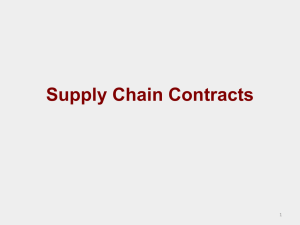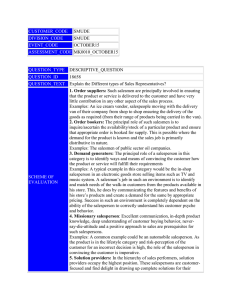E-Commerce chapter 1
advertisement
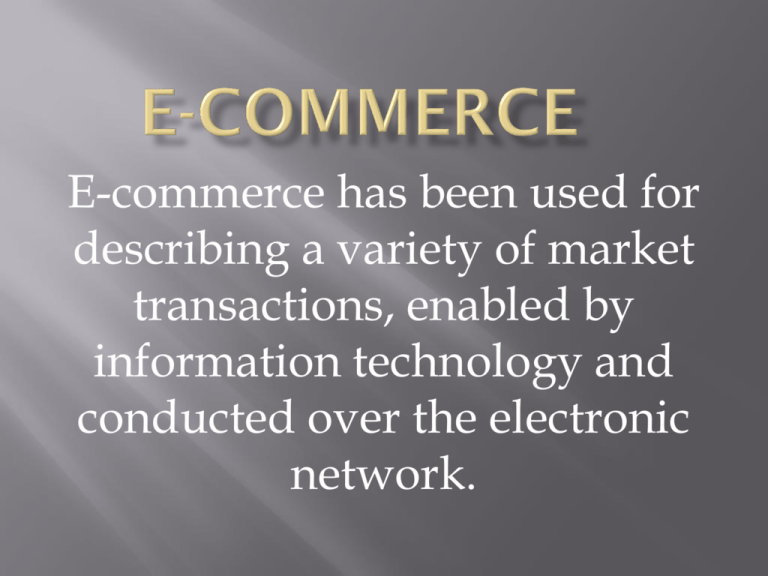
E-commerce has been used for describing a variety of market transactions, enabled by information technology and conducted over the electronic network. Manufacturer Wholesaler Wholesaler Retailer Retailer Consumer Consumer Wholesaler Retailer Consumer Manufacturer Retailer Retailer Consumer Consumer Retailer Consumer Manufacturer Consumer Consumer Consumer • The Auctions are a market mechanism for trading the items at a market-negotiated price based upon the demand and supply. • The Internet has added a new dimension by creating an online mechanism for implementing the Auction process. • The auction mechanisms implemented using the electronic commerce technologies allows people connected through the Internet to bid online. • The Electronic auctions potentially encourage greater participation as any Internet users with access to site hosting an auction can bid. • For Example, AuctionIndia.Com, Ebay.com • The electronic banking empowers the consumers to access their accounts, carry out transactions through the Web browsers or Web enabled personal software packages. • The customers can view account details, transfer funds, pay bills, order checks and review account history. • Examples, ICICI Bank, HDFC Bank • Internet and electronic commerce technologies have put the information few key strokes away from people connected to Internet. • Web browser can be used for accessing the functionality offered by telephone directories by interfacing the directory database with the Web (HTTP) server. • The complete functionality offered by telephone directory service provider can be offered through a single web interface without any human intervention all the time from all the locations. • Example, Whowhere.com, yp.intel.com, • World Wide Web is a vast sea of information. Contains personal pages, business pages, and general information on many topics and subjects. • Locating relevant information in an ocean of over 1.3 billion pages can be a Herculean task. • Many companies have built information retrieval systems that assist in searchin the information based on keywords and text. • Eaxample, Yahoo (http://www.yahoo.com), Altavista (http://www.altavista.com), Google (http://www.google.com), Khoj (http://www.khoj.com), and India123 (http://www.india123.com) • IDC defines e-Learning as the concept of delivering training over the Internet to the desktop. Internet empowers professionals with flexible training, customized learning, work schedules. • CD-ROM offered Computer Based Training (CBT) which is transportable, cost efficient, "anytime anywhere" training. • Internet and WWW provided the capabilities of basic mentoring through email, delivery of content in text with simple graphics, and lowquality Web-casts. • Due to growth Internet technologies and bandwidth, today training is characterized by Java/IP network applications, rich streaming media, high bandwidth access, and live, virtual classrooms over the Web with real-time monitoring. • It is capable of providing content in multiple formats as an integrated suite that is focused on the learner as opposed to force-fitting old CDROM technology into a Web format. • A good e-Learning solution is a full sensory type of approach to technology and education consisting of animations, the multiple voices, the humor, the games, the interaction, the hands-on labs, the simulations, the demos. • The on line instructor can interact and explain concepts and clear doubts to anyone attending a course, no matter where the students are located as long as they are sitting in connected classrooms. The traditional marketing faces following major challenges: • Higher Costs: – Costs to produce brochures and product data sheets, shipping and mailing. The support for consumer queries requires more human resources. • Hit Ratio: – The direct mail even in the targeted market place suffers from extremely low response rates. • Time Intensive: – A preparation of an advertisement or a marketing brochure may require several rounds of revisions leading to delays in dealing with ad agencies and printers. Also, the prepared advertisement may sometimes have to wait for a long period due to suitable slot availability in the media. The Internet advertising offers following advantages: • Cost Savings: – The catalogues, brochures, product specifications prepared in the electronic form and delivered through the Internet offer huge savings in copy editing, printing, packaging and shipping costs and updating them as and when required. Also, it cuts the time to put the information on customers hand the up to date information is available to customers worldwide continuously through the reach of Internet. • Lower Barrier to Entry: – The size of business, location of business and the brick and mortar infrastructure does not matter when you are present on Internet. Electronic commerce universe is a great leveler. It offers equal opportunity to one and all by lowering the barriers to access the marketplace. The supply chain management deals with three issues: • Coordinating all the order processing activities that originate at the customer such as process of order generation, order acceptance, entry into order processing system, prioritization, production and material forecast; • Material related activities such as scheduling, production, distribution, fulfillment and delivery; • Financial activities such as invoicing, billing, fund transfer and accounting. The electronic commerce technologies assist in: • Linking and managing digitized products, product information, processes and intercommunication among organizations. • The primary goal of streamlining the product delivery from manufacturer to the customer can be better served with digital communication, sharing of information/ databases and coordination across number of organization in the 'chain'. • Through the use JAVA and XML, members of a supply chain can pool together heterogeneous resources and skills for sharing and exchange of information to deliver the outcome as one "virtual“ organization. The emergence of Virtual organizations is driven by – The globalization of the economy leading to the access to resources from across the world. – The restructuring of industry due to new economic realities and WTO. – Emergence of the electronic commerce driven by Internet technology for new mode of interaction between manufacturers, suppliers, distributors and customers. • The electronic trading is a mechanism that utilizes the power of electronics and communication media such as Internet to bring together geographically dispersed buyers and sellers on a virtual common trading platform. • The virtual platform offers aggregated information to all the participants in a fair manner. The platform facilitates the access to aggregate information, order booking and fulfillment. • In the context of stock markets, the e-trading means buying and selling equity online through electronic means. • Examples: ICICIdirect, E-trade, Fidelilty, Charles Schwab
